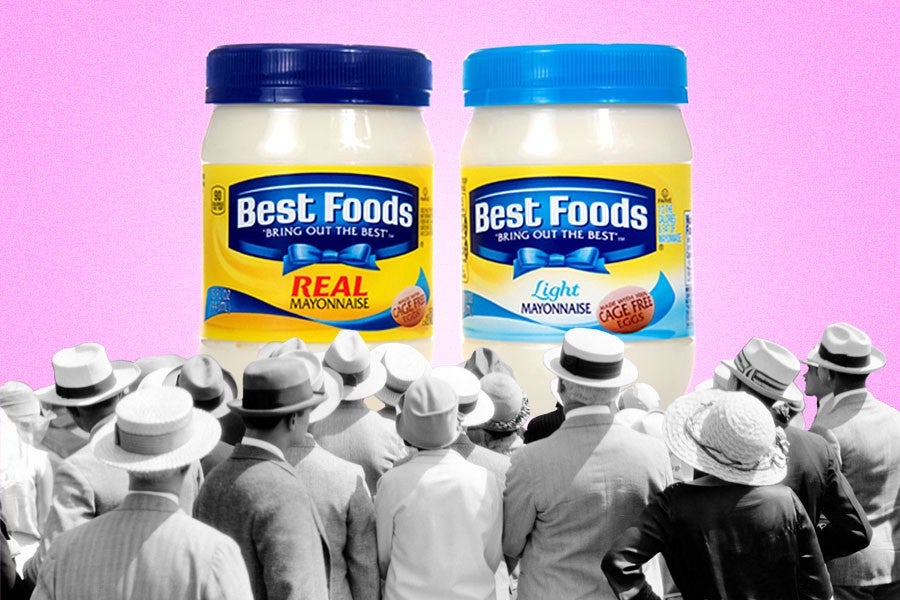I grew up eating a lot of incredible produce in rural Tennessee. Like most poor, farm-descending people I knew, we were always growing, or related to someone growing, a garden full of tomatoes, corn, okra and green beans. But we had to use food stamps for everything else, which means I also ate a lot of dog-shit food: Vienna sausages, bologna cups, fried-egg-and-tomato sandwiches, BLTs and anything else you could cobble together with the cheapest bread, meat, produce and dairy available.
To tart this stuff up, we flavored every vegetable with lard, and we put mayo on every sandwich.
So as you can imagine, I was saddened to hear that mayonnaise was declared dead this week. The perp, according to Philadelphia magazine: millennials. It turns out that young people aren’t gulping this stuff down like they used to. There are more and healthier-seeming condiments out there.
That’s sad. As Philadelphia writer Sandy Hingston notes, mayo has a long history of both disguising flaws of less-than-stellar foods, and being, as chef Scott Jones once said, “the perfect flavor carrier.”
“It just makes everything better,” Hingston writes.
That set off a “fun” Twitter debate about mayo. Sure, some said, it’s tiring to finger millennials for every flailing industry. But maybe mayo deserves to die because it’s a gross, greasy trash food whose time is up.
If Millennials really did kill mayonnaise, they are truly the greatest generation. https://t.co/6TkjI5R188
— Jeet Heer (@HeerJeet) August 12, 2018
yes, the mayonnaise salad deserved to die and i’m glad my generation did it. https://t.co/GviXC4FSl2
— jamelle g-g-ghoulie ? (@jbouie) August 12, 2018
Mayo is gross and I hate it, but if you throw it on something and I pretend it’s not there, I’ll eat it.. but yes, mayo = gross
— Crypto Bobby (@crypto_bobby) July 9, 2018
Hmm. Beg to differ. Is hollandaise gross? Is aioli gross? Call it by whatever you name you want, but both are still just fancier forms of mayo.
Mayo is basically eggs, oil and vinegar, some salt and maybe some sugar, and it’s whisked together in a process called emulsion.
Mayo also started out really blue-blood. As Hingston notes, the place it originated is debated, but it appears to have begun in 1756 as a Spanish or French shortcut for a cream sauce using whatever was around (which were eggs and oil). Then it shows up at an upscale New York restaurant in America in 1838. It doesn’t trade itself down until 1937, when, to its popularity and the rise of refrigeration for regular people, it’s being written about as a staple of workers’ tables.
In other words, as long as most anyone reading this has been alive, it’s been a commoner condiment most of us could get our hands on.
I’m no food critic, but mayo has a creamy consistency that somehow allows you to taste the food it’s next to better, like some kind of culinary osmosis. Because it’s made of eggs and oil, critically, it’s adding protein and heft to anything it’s added to. Stuff like this (peanut butter, eggs, mayo, beans) are the staples of the poor for a reason. They’re cheap fillers. You can eat a little and it goes a long way on feeling full when you’ve run out of groceries before you’ve run out of month. It also binds together what wouldn’t stick together on its own. Potato salad without mayo is just, well, potatoes and some seasonings.
But that makes it sound like a necessity, when it’s actually also good. I’m not saying mayo tastes like much in and of itself. It is fairly bland unless you season it; I can’t really speak to its flavor profile. It’s the texture that counts. Why its creamy-rich cooling powers work so well on a spicy fried-chicken sandwich, a turkey club, a hamburger and a peanut butter and banana sandwich (yes, a Southern delicacy) is a mystery to me, but it’s a testament to how something so basic and cheap can be versatile enough to make a simple, sad situation feel luxurious.
I understand this very texture thing (one woman’s creamy delight is another woman’s slimy glob) is also what repulses a lot of people about mayo. A food sensory consultant for Hellman’s told Popular Science a few years ago that about 20 percent of the population actually finds mayo disgusting, and that it’s polarizing in Europe and Asia, too. It’s just that the moisture it provides as a flavor carrier is so useful to carry taste in the mouth. No one likes a dry sandwich.
Slate investigated the seeming hatred of mayo as bland white-people food and found that there’s not a lot of basis in the scorn. Even though Milton Berle joked that “anytime somebody orders a corned beef sandwich on white bread with mayonnaise, somewhere in the world, a Jew dies,” Jewish folks also use Russian dressing, which has mayo. Mayo-filled egg salad is a deli staple. And Berle himself ate corned beef on white bread… with mayo.
Films such as 2002’s Undercover Brother may be the culprit for modern-day scorn. In it, they joked that liking mayo was a path to passing for white. But Damon Young at Very Smart Brothas recently explained why potato salad — ahem, mayo — is a “black people” food. And on other forums online, some people argue that this perception of mayo just being white exists in one place only: On the internet. In response to the question “What is this myth that black people don’t eat mayonnaise?,” Spliz writes:
Every black person I know puts Mayo on some form of sandwich. Not including all the fukkin fast food restaurants that put Mayo on the burgers or chicken sandwich automatically. Scream black people don’t eat mayo whIle eating the mac sauce from Mcdonalds. Potato salad from yo grandma crib. Macaroni salad. Etc etc. I honestly believe that stupid stereotype came from Undercover Brother.
“Exactly,” Jasmine20 responds. “Most black people I know in rl love potato salad or macaroni salad. Only on the internet is eating mayonnaise seen as a white thing and black people hate it.”
So what’s going on here, aside from obvious individual differences in preference that have nothing to do with race or generation? The differences could be regional, too. Or, there may be some confusion over the usage of “real mayonnaise” versus Miracle Whip, which — important! — debuted during the Great Depression as a cheaper alternative to mayo.
In 2009, Ta-Nehisi Coates responded to a commenter who was upset that Coates blamed white people for excessive mayonnaise enthusiasm. The commenter claims mayo has “long officially been black.”
Coates disagrees, but lets another commenter explain why:
…in our community, the condiment ingredient of potato salad is actually Miracle Whip instead of Mayo. This is nearly universal to the degree that there are entire generations who are unaware that “mayonnaise” and Miracle Whip are in fact different. Many of us, never having tasted actual mayonnaise until adulthood, find its taste off-putting but still use the terms interchangeably.
This actually mirrors my experience as a white Southerner. I grew up eating “real” homemade mayo at my grandmother’s and great-grandmother’s, but Miracle Whip at home. That’s because they made mayo themselves, from scratch. But if they needed to buy it at the store, they splurged on what tasted like what they made, which was occasionally the pricier Hellman’s.
But in my household with a single working mother, there wasn’t time to make mayo by hand the real way, nor was there money to buy Hellman’s. So we had Miracle Whip.
The difference between them? As Dave Stagner explains in a piece exploring it, it’s only our snobby bullshit. The FDA doesn’t let Miracle Whip call itself mayo because “real” mayo has to be 65 percent oil. Miracle Whip does not disclose the amount of oil, but presumably has less than 65 percent oil. Everything else in it is the same.
Stagner admits the flavor and texture are different — to me, real mayo has a stronger flavor, and I prefer the almost tangier Miracle Whip — but the rest, he says, is classist cockamamie:
And then it hit me — this is about social class, not authenticity.
Mayonnaise is middle class/rich people’s food. Miracle Whip is poor people’s food, the stuff of blacks, rednecks, and other social inferiors. Mayo, or “aioli,” is seen as “authentic” because it’s a product of European cultural heritage, the same cultural heritage that considers (explicitly or not) French food to be inherently superior to all other cuisines.
Miracle Whip is mayonnaise. It’s made the same way, from the same ingredients. It can’t be called “mayo” due to FDA regulations about proportions, not because it’s fundamentally different in any way. Hellman’s is the same thing, made the same way from the same ingredients for the same market — shelf-stable dressing. It’s sold as “real” mayonnaise as an explicit capitalization on the class snobbery that marks the mayo/Miracle Whip divide. And it works.
This might sound like we’re all just missing a key difference in the culinary debate: The difference between “Southern food” and “soul food,” which is undergoing a critical reexamination, so credit goes where it’s due. But in a recent New York Times interview, chef Todd Richards, who is black, says the difference is more about class than race. “People get preoccupied with skin color. But it’s really a question of poor and wealthy.” In other words, the ingredients are often the same — it’s just the quality of the part.
Mayo or Miracle Whip — regardless of which one is more “real,” the entire food now seems to be associated dismissively with poor people of any race and the trash foods they like. It’s become the stuff of podunk family reunions and BBQ-shack sides. It’s in ranch dressing (it instantly improves all shitty fried foods), tartar sauce (a must-have for fried fish, which, remember, is not fresh fish, because you’re poor), chicken salad, egg salad and coleslaw. It’s on po’ boys, in pimento cheese, on a tomato-and-mayo sandwich.
Poor people also used it to thickly coat the hair of a child with lice long before it became a cool nontoxic hack. They still use it in a chocolate cake because that’s what women did during the Depression when they couldn’t spare another egg (also, it’s delicious and makes the cake moist as fuck). They use it to moisturize their hair and to clean and shine plant leaves. Try doing any of that shit with ketchup.
But calling mayo a bland white-people food makes it easy to hate. White people — and our love of things like racism, Taco Bell and President Trump — have clearly earned the gibe. But comparing mayo to whiteness does a disservice to mayo. Mayonnaise deserves better.
Of course, none of this is as important as what I saved for last: Mayonnaise isn’t actually dead. For starters, the only “evidence” in the Philadelphia piece is Hingston’s own personal anecdotes about her family’s eating preferences and the fact that BuzzFeed wrote something about how it sucks.
Business Insider found that the small decline in Hellman’s sales (6.7 percent from 2012 to 2017), is minor and for a few reasons: People of all ages are generally more health-conscious, and mayo is fattening. But there’s also just more condiment diversity now. People like wasabi and sriracha now. There are more available types of mayo on the market today: mayo-ketchup, garlic mayo, chipotle mayo, sriracha mayo, vegan mayo and even mayonnaise ice cream.
All this means is mayo has expanded into something even more dynamic than it once was. You don’t have to like it, but we should recognize that its blank-slate-ness is precisely why it has managed to remain the slippery culinary (and life-) hack it has always been. Mayo simply caught up with the changing times to incorporate, elevate and transport newer, more exciting, more diverse flavors. Too bad the rest of us haven’t.

